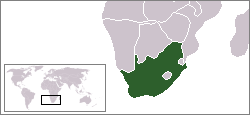De Hoop Nature Reserve
|
De Hoop Nature Reserve
|
|
|
Black oystercatcher |
|
| location | South Africa |
| surface | 350 km² |
| Geographical location | 34 ° 26 ′ S , 20 ° 30 ′ E |
| Setup date | 1957 |
| administration | CapeNature |
The nature reserve De Hoop Nature Reserve is located about 250 km east of Cape Town and 60 km southwest of Swellendam between Bredasdorp and Witsand and is the southernmost nature reserve in Africa. It is part of the Cape Floral and belongs to since 2004 UNESCO - World Heritage . It is located on a stretch of coast with extensive white sand dunes in the western part and rocky bays framed by cliffs in the eastern part. The protected area is managed by CapeNature.
history
In 1956 some farms were bought and a year later the area was declared a nature reserve. Farm De Hoop gave the protected area its name. Through various expansions in the following years, the size has grown to 35,000 hectares. The protected area has a coastline of 45 kilometers in length and was expanded by another 23,000 hectares in 1986 by the de Hoop Marine Reserve , an extension of the protection status by five kilometers into the sea.
The climate is Mediterranean, with hot summers and mild winters. The annual rainfall is around 380 mm, August is the wettest month.
Flora and fauna
The purpose of the protected area is
- Protection of the diverse fynbos vegetation: 1,500 plant species in the protected area, of which 108 species are very rare or endangered and 34 species are endemic there
- Conservation of the wetland "De Hoop Vlei"
In addition to the flora, the following are also protected here:
- 89 mammalian species (eg. B. mountain zebra , eland , Kuhantilope , Blesbok )
- 250 species of birds
- 14 amphibian species
- 50 species of reptiles.
In the west of the reserve is one of the largest brackish water lagoons in southern Africa, the “De Hoop Vlei”. Thousands of water birds find refuge and food here. The number and type of birds depend on the seasons and water levels. You can see flamingos , herons , ducks, comb coots , Egyptian geese , plovers , crescent sandpipers and the threatened black oystercatchers and damara terns . The "De Hoop Vlei" is designated as a Ramsar wetland .
The only breeding colony of Cape vultures on the southwestern cape is in the Potberg region in the northeast of the protected area . In 1982 there were only 20 breeding pairs, but thanks to the consistent protective measures, the number has increased again to 75 breeding pairs.
In the spring you can from the dunes from herds of Southern Right Whales watching (Southern Right Whale), the coastline is mating and breeding area of this species of whale.
The chains of high, white dunes stretch along the coast for kilometers, which merge into rocky tide pools from the “Koppie Alleen” vantage point, which is used for whale watching.
An eleven kilometer long driveway leads through the protected area with a few branches. Since there are no larger predators, you can explore the entire area on foot - even on hikes lasting several days.
Web links
- Website of the park administration CapeNature (English)
- Entry in the UNESCO World Heritage List (English) (French)







